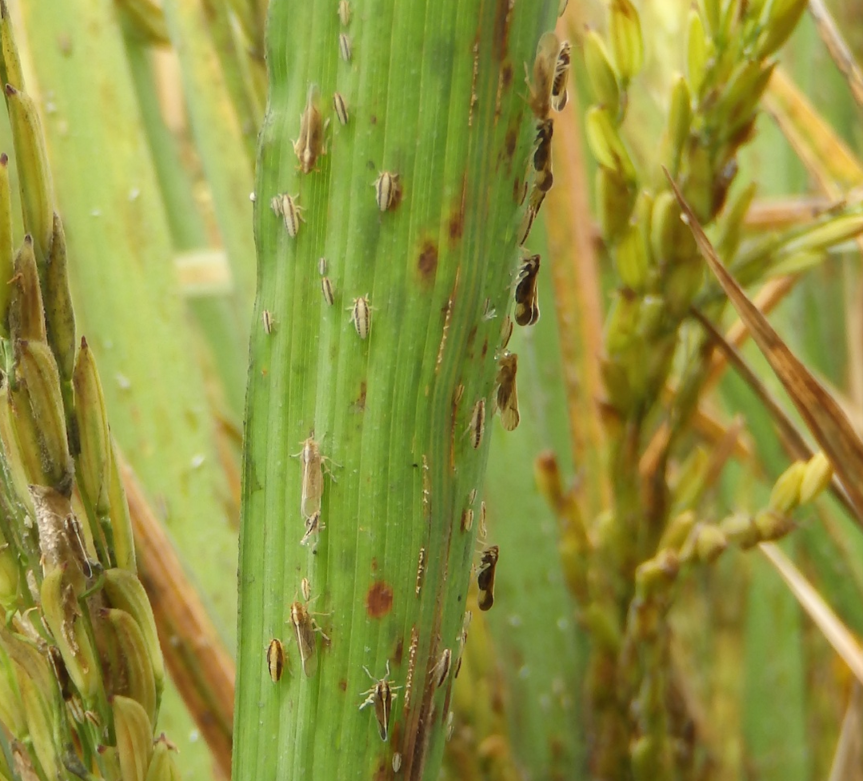Rice Delphacid found in Arkansas, growers urged to scout late planted fields
Sept. 15, 2025
By Sarah Cato
Fast facts
- Rice delphacid found for first time in Arkansas
- Growers should scout green fields
- Treatment options are limited, growers urged to share new populations with UA Extension.
(732 words)
NEWSROOMS download photos of rice delphacid.
LITTLE ROCK — Rice delphacid, a planthopper that has been a serious pest in central and southern America and the Caribbean, has been found in Arkansas. While most of the state’s rice is either harvested or almost ready for harvest, there are some late planted fields that need to be scouted.

Rice delphacid had been present in Arkansas in the 1950s, then seemed to vanish. However, it reappeared on entomologists’ radars when it was confirmed in Texas in 2015 and this year was found in northern Louisiana and Arkansas. The insect has been confirmed in Miller and Lafayette counties in southwestern Arkansas. It has also been found as far north as Jefferson County and in at least one field north of I-40 in Woodruff County. Populations have also been found in Washington County in Division of Agriculture research plots.
“In general, this year’s crop is far enough along that there isn’t too much concern for this year’s rice,” said Nick Bateman, extension rice entomologist for the University of Arkansas System Division of Agriculture. “However, we still want to monitor its spread and take any opportunity this year to look at control options in case this pest decides to stay around for future seasons.”
Rice delphacid are small insects. Adult males have dark-colored wings, and females have tan-colored wings that blend in with rice straw. Nymphs are oval shaped, tan-colored and have racing stripes down their sides. Bateman said the nymphs are “unique and pretty hard to miss.”
Signs of damage and control options
Bateman said rice fields that are green, in late boot to early heading stages, are still a concern for rice delphacid.
“Rice delphacid feeding damage – what we call hopper burn – dries out the rice and causes burn symptoms and can kill the plant,” Bateman said. “Additionally, rice delphacid is a vector for Rice Hojo Blanca Virus, which presents as white bands on rice leaves and can cause panicle deformation and reduced tillers.”
Bateman said control options in Arkansas are limited.
“Right now our only option is Tenchu, but it does help. Some growers in Louisiana are adding Dimilin, but we have to be careful with that preharvest interval,” Bateman said. “These things can blow up overnight, so we’ll need to treat at low populations. Do not wait to see hopper burn areas in the field before deciding to look for this pest, because at that point we may not be able to slow it down.”
Bateman and extension rice agronomist Jarrod Hardke are asking growers to report any findings of rice delphacid to their local county agent.
Mention of product name does not imply endorsement by the University of Arkansas System Division of Agriculture.
To learn more about Division of Agriculture research, visit the Arkansas Agricultural Experiment Station website: https://aaes.uada.edu. Follow on Twitter at @ArkAgResearch. To learn more about the Division of Agriculture, visit https://uada.edu/. Follow us on Twitter at @AgInArk. To learn about extension programs in Arkansas, contact your local Cooperative Extension Service agent or visit www.uaex.uada.edu.
About the Division of Agriculture
The University of Arkansas System Division of Agriculture’s mission is to strengthen agriculture, communities, and families by connecting trusted research to the adoption of best practices. Through the Agricultural Experiment Station and the Cooperative Extension Service, the Division of Agriculture conducts research and extension work within the nation’s historic land grant education system.
The Division of Agriculture is one of 20 entities within the University of Arkansas System. It has offices in all 75 counties in Arkansas and faculty on five system campuses.
The University of Arkansas System Division of Agriculture offers all its Extension and Research programs and services without regard to race, color, sex, gender identity, sexual orientation, national origin, religion, age, disability, marital or veteran status, genetic information, or any other legally protected status, and is an Affirmative Action/Equal Opportunity Employer.
# # #
Media Contact: Sarah Cato
U of A System Division of Agriculture
Cooperative Extension Service
980-815-9035